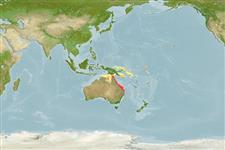>
Acanthuriformes (Surgeonfishes) >
Pomacanthidae (Angelfishes)
Etymology: Chaetodontoplus: Greek, chaite = hair + Greek, odous = teeth + Greek, plous, ous, oo = crossing (Ref. 45335).
Environment: milieu / climate zone / depth range / distribution range
Écologie
marin récifal; non migrateur; profondeur 10 - 50 m (Ref. 48391). Subtropical
Western Pacific: Queensland, Australia. Reported to range south to New South Wales and Lord Howe Island (Ref. 9710).
Taille / Poids / Âge
Maturity: Lm ? range ? - ? cm
Max length : 25.0 cm TL mâle / non sexé; (Ref. 2334)
Description synthétique
Morphologie | Morphométrie
Épines dorsales (Total): 13; Rayons mous dorsaux (Total): 17-19; Épines anales 3; Rayons mous anaux: 17 - 19. Trunk black; the forehead, snout, breast, and caudal fin yellow; side of the head mostly blue with yellow spots; a wide white bar just behind the head, running from the below the forehead to the base of the pectoral fin; dorsal and anal fins with narrow yellowish to bluish white margin.
Inhabits coastal reefs and open bottoms with rock , coral, sponge, or seawhip outcrops to depths greater than 3 5 m (Ref. 9710). Juveniles often among sponges under jetties; adults often in pairs, generally in deeper water (Ref. 9710). Feeds on sponges and tunicates. Solitary or forms pairs or small groups. Occasionally exported through the aquarium trade (Ref. 48391).
Life cycle and mating behavior
Maturité | Reproduction | Frai | Œufs | Fécondité | Larves
Randall, J.E., G.R. Allen and R.C. Steene, 1990. Fishes of the Great Barrier Reef and Coral Sea. University of Hawaii Press, Honolulu, Hawaii. 506 p. (Ref. 2334)
Statut dans la liste rouge de l'IUCN (Ref. 130435)
Menace pour l'homme
Harmless
Utilisations par l'homme
Plus d'informations
Noms communsSynonymesMétabolismePrédateursÉcotoxicologieReproductionMaturitéFraiRassemblement de ponteFéconditéŒufsDéveloppement de l'œuf
Taille/ÂgeCroissanceLongueur-poidsLongueur-longueurFréquences de longueursMorphométrieMorphologieLarvesDynamique des populations larvairesRecrutementAbondanceBRUVS
RéférencesAquacultureProfil d'aquacultureSouchesGénétiqueElectrophoresesHéritabilitéPathologiesTraitementNutrientsMass conversion
CollaborateursImagesStamps, Coins Misc.SonsCiguateraVitesseType de nageSurface branchialeOtolithesCerveauxVision
Outils
Articles particuliers
Télécharger en XML
Sources Internet
Estimates based on models
Preferred temperature (Ref.
123201): 23.9 - 27.6, mean 26.1 °C (based on 78 cells).
Phylogenetic diversity index (Ref.
82804): PD
50 = 0.5000 [Uniqueness, from 0.5 = low to 2.0 = high].
Bayesian length-weight: a=0.03090 (0.01359 - 0.07026), b=2.89 (2.70 - 3.08), in cm total length, based on LWR estimates for this (Sub)family-body shape (Ref.
93245).
Niveau trophique (Ref.
69278): 3.0 ±0.00 se; based on food items.
Résilience (Ref.
120179): Milieu, temps minimum de doublement de population : 1,4 à 4,4 années (Preliminary K or Fecundity.).
Fishing Vulnerability (Ref.
59153): Low vulnerability (15 of 100).
Nutrients (Ref.
124155): Calcium = 35.9 [16.1, 68.0] mg/100g; Iron = 0.559 [0.324, 0.970] mg/100g; Protein = 19 [18, 20] %; Omega3 = 0.161 [0.092, 0.274] g/100g; Selenium = 14 [7, 29] μg/100g; VitaminA = 47.1 [12.0, 179.4] μg/100g; Zinc = 0.898 [0.572, 1.360] mg/100g (wet weight);
